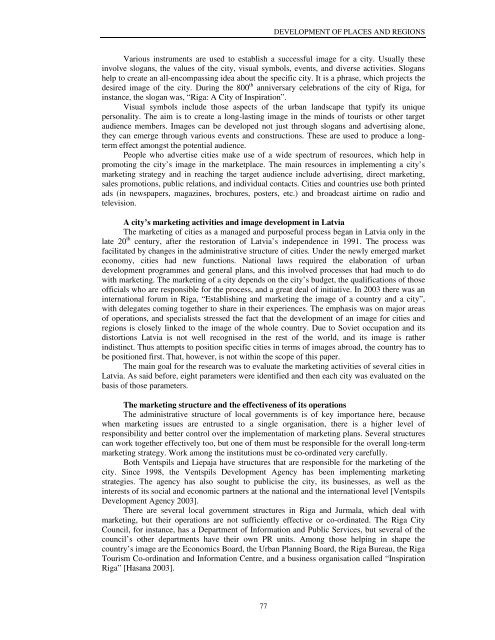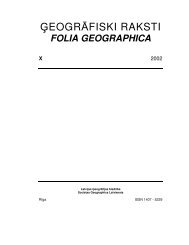eogrÄfiski raksti folia geographica xii - Ä¢eogrÄfijas un Zemes zinÄtņu ...
eogrÄfiski raksti folia geographica xii - Ä¢eogrÄfijas un Zemes zinÄtņu ...
eogrÄfiski raksti folia geographica xii - Ä¢eogrÄfijas un Zemes zinÄtņu ...
Create successful ePaper yourself
Turn your PDF publications into a flip-book with our unique Google optimized e-Paper software.
77<br />
DEVELOPMENT OF PLACES AND REGIONS<br />
Various instruments are used to establish a successful image for a city. Usually these<br />
involve slogans, the values of the city, visual symbols, events, and diverse activities. Slogans<br />
help to create an all-encompassing idea about the specific city. It is a phrase, which projects the<br />
desired image of the city. During the 800 th anniversary celebrations of the city of Riga, for<br />
instance, the slogan was, “Riga: A City of Inspiration”.<br />
Visual symbols include those aspects of the urban landscape that typify its <strong>un</strong>ique<br />
personality. The aim is to create a long-lasting image in the minds of tourists or other target<br />
audience members. Images can be developed not just through slogans and advertising alone,<br />
they can emerge through various events and constructions. These are used to produce a longterm<br />
effect amongst the potential audience.<br />
People who advertise cities make use of a wide spectrum of resources, which help in<br />
promoting the city’s image in the marketplace. The main resources in implementing a city’s<br />
marketing strategy and in reaching the target audience include advertising, direct marketing,<br />
sales promotions, public relations, and individual contacts. Cities and co<strong>un</strong>tries use both printed<br />
ads (in newspapers, magazines, brochures, posters, etc.) and broadcast airtime on radio and<br />
television.<br />
A city’s marketing activities and image development in Latvia<br />
The marketing of cities as a managed and purposeful process began in Latvia only in the<br />
late 20 th century, after the restoration of Latvia’s independence in 1991. The process was<br />
facilitated by changes in the administrative structure of cities. Under the newly emerged market<br />
economy, cities had new f<strong>un</strong>ctions. National laws required the elaboration of urban<br />
development programmes and general plans, and this involved processes that had much to do<br />
with marketing. The marketing of a city depends on the city’s budget, the qualifications of those<br />
officials who are responsible for the process, and a great deal of initiative. In 2003 there was an<br />
international forum in Riga, “Establishing and marketing the image of a co<strong>un</strong>try and a city”,<br />
with delegates coming together to share in their experiences. The emphasis was on major areas<br />
of operations, and specialists stressed the fact that the development of an image for cities and<br />
regions is closely linked to the image of the whole co<strong>un</strong>try. Due to Soviet occupation and its<br />
distortions Latvia is not well recognised in the rest of the world, and its image is rather<br />
indistinct. Thus attempts to position specific cities in terms of images abroad, the co<strong>un</strong>try has to<br />
be positioned first. That, however, is not within the scope of this paper.<br />
The main goal for the research was to evaluate the marketing activities of several cities in<br />
Latvia. As said before, eight parameters were identified and then each city was evaluated on the<br />
basis of those parameters.<br />
The marketing structure and the effectiveness of its operations<br />
The administrative structure of local governments is of key importance here, because<br />
when marketing issues are entrusted to a single organisation, there is a higher level of<br />
responsibility and better control over the implementation of marketing plans. Several structures<br />
can work together effectively too, but one of them must be responsible for the overall long-term<br />
marketing strategy. Work among the institutions must be co-ordinated very carefully.<br />
Both Ventspils and Liepaja have structures that are responsible for the marketing of the<br />
city. Since 1998, the Ventspils Development Agency has been implementing marketing<br />
strategies. The agency has also sought to publicise the city, its businesses, as well as the<br />
interests of its social and economic partners at the national and the international level [Ventspils<br />
Development Agency 2003].<br />
There are several local government structures in Riga and Jurmala, which deal with<br />
marketing, but their operations are not sufficiently effective or co-ordinated. The Riga City<br />
Co<strong>un</strong>cil, for instance, has a Department of Information and Public Services, but several of the<br />
co<strong>un</strong>cil’s other departments have their own PR <strong>un</strong>its. Among those helping in shape the<br />
co<strong>un</strong>try’s image are the Economics Board, the Urban Planning Board, the Riga Bureau, the Riga<br />
Tourism Co-ordination and Information Centre, and a business organisation called “Inspiration<br />
Riga” [Hasana 2003].

















